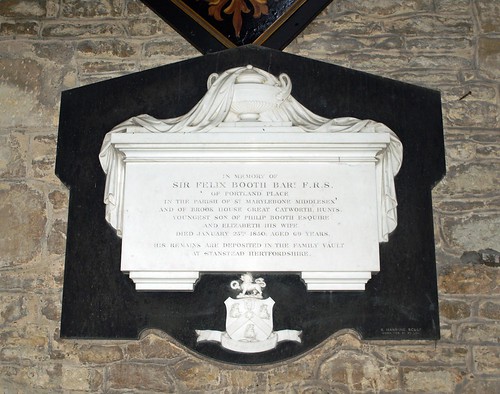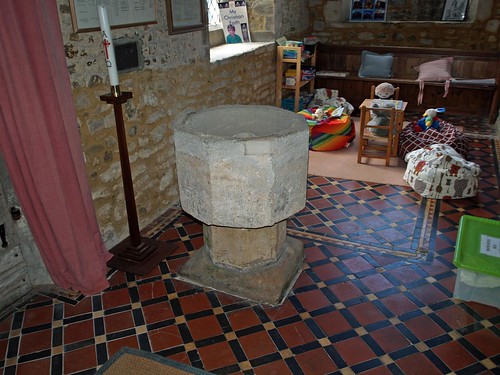ST LEONARD. A late C14 church, except for the half-destroyed E.E. DOUBLE PISCINA in the chancel and the lavish E.E. S doorway with three orders of shafts carrying mature stiff-leaf capitals and an arch of three hollow chamfers. The W tower is slender, ashlar-faced and well detailed. A W window which is a spherical triangle with six spokes as tracery is still essentially Dec, and so are the two-light bell-openings with transom. But the top frieze, the battlements, and the recessed spire (with two tiers of lucarnes) are Perp.* The arcades of four bays inside are quite typical of the late C14, i.e. the standard Perp moulded pier-section but still rounded bases and capitals and still sunk-quadrant mouldings in the arches. The chancel arch matches. Later clerestory and nave roof (almost entirely renewed) with traceried spandrels of the braces and carved bosses. Bosses also on the S aisle roof. - PULPIT. Of wood; Perp. - SCREEN. Perp, of three-light divisions. - SCULPTURE. A stiff-leaf bracket in the N aisle. - CHANDELIER. Of brass, dated 1666 and inscribed by Brasenose College. - STAINED GLASS. Fragments in the chancel S windows. - PLATE. Cup of 1568-9; C17 Paten; Jug of 1771-2; Plate of 1778-9. - MONUMENTS. Tablets with simple urn at the top to Elizabeth Booth d. 1846 by Maile & Son and to Sir Felix Booth F.R.S. d. 1850 by S. Manning jun.
* The gargoyle on the N side is re-used and marks the outlet of a flue from a recess inside, probably for baking the communion wafers.
CATWORTH. It gave London a Lord Mayor, but it sold a precious fragment of its heritage. A pleasant village with thatched cottages 300 years old, it gathers round a handsome church which has come down from our three great building centuries.
The tower and its spire look down on venerable yews. The south doorway has capitals decorated with foliage by a sculptor who was in his grave before Chaucer was in his cradle. Its door, like the door to the turret stairway, was made about 400 years ago. The roofs of the nave and aisles are older still, and have bold foliage and faces.
There is a fine Jacobean altar table, a pulpit with traceried panels that have been admired for 500 years, and a chancel screen with arches like beautiful windows, the glorious work of the 15th century builder of the chancel. A fragment of carved stone and a coffin lid must be older than Magna Carta, and the altar cup was made before the Armada came. Among fragments of 15th century glass are flowers and foliage in red, blue, and gold. In the nave hangs a brass candelabra with a double-headed eagle given by a London man in the year of the Great Fire.
Nothing could be simpler than the font carved 600 years ago. We like to think that at it Wolstan Dixie was baptised in 1525. He ran about this village as a little fellow, and is remembered as the Dick Whittington of Huntingdon. The village had been the home of his people for generations and they had rich lands, but Wolstan was the fourth son of his father and was apprenticed to Sir Christopher Draper, a city merchant of the Ironmongers Company. The young apprentice found favour in his master’s sight, and he captured the heart of his master’s daughter whom he married. Sir Christopher was Lord Mayor in 1566, and Sir Wolstan (as he became) followed his example in 1585. Active, generous, and of high renown, he died in 1593, leaving an annuity to Christ’s Hospital, a fund to help young merchants, coals to the poor of his parish, money for prisoners and maids, and a fund to establish a lecture at a London church.
But the treasure Catworth has no more, having sold it, is a set of five cushions with quaint figures of kings and saints, exquisite examples of 14th century needlework. It was a sad day when these things were sold to South Kensington, where we must go to the Victoria and Albert Museum to see them. Perhaps the museum will return them to their old home.
The tower and its spire look down on venerable yews. The south doorway has capitals decorated with foliage by a sculptor who was in his grave before Chaucer was in his cradle. Its door, like the door to the turret stairway, was made about 400 years ago. The roofs of the nave and aisles are older still, and have bold foliage and faces.
There is a fine Jacobean altar table, a pulpit with traceried panels that have been admired for 500 years, and a chancel screen with arches like beautiful windows, the glorious work of the 15th century builder of the chancel. A fragment of carved stone and a coffin lid must be older than Magna Carta, and the altar cup was made before the Armada came. Among fragments of 15th century glass are flowers and foliage in red, blue, and gold. In the nave hangs a brass candelabra with a double-headed eagle given by a London man in the year of the Great Fire.
Nothing could be simpler than the font carved 600 years ago. We like to think that at it Wolstan Dixie was baptised in 1525. He ran about this village as a little fellow, and is remembered as the Dick Whittington of Huntingdon. The village had been the home of his people for generations and they had rich lands, but Wolstan was the fourth son of his father and was apprenticed to Sir Christopher Draper, a city merchant of the Ironmongers Company. The young apprentice found favour in his master’s sight, and he captured the heart of his master’s daughter whom he married. Sir Christopher was Lord Mayor in 1566, and Sir Wolstan (as he became) followed his example in 1585. Active, generous, and of high renown, he died in 1593, leaving an annuity to Christ’s Hospital, a fund to help young merchants, coals to the poor of his parish, money for prisoners and maids, and a fund to establish a lecture at a London church.
But the treasure Catworth has no more, having sold it, is a set of five cushions with quaint figures of kings and saints, exquisite examples of 14th century needlework. It was a sad day when these things were sold to South Kensington, where we must go to the Victoria and Albert Museum to see them. Perhaps the museum will return them to their old home.



No comments:
Post a Comment